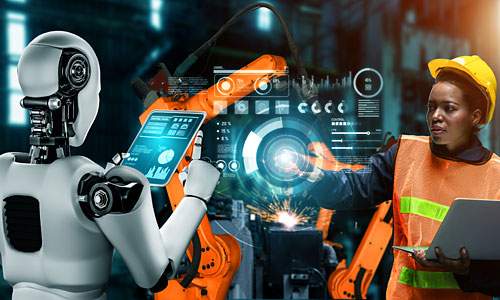Work Intensification: Automation's New Problem July 2022
Want more free featured content?
Subscribe to Insights in Brief

AI's long-term impact on employment is still unknown, and researchers' predictions vary widely. A 2013 paper by University of Oxford researchers estimated that almost half of US jobs were vulnerable to computerization, though it did not specify a timeline. And a 2018 study by the OECD estimated that 14% of jobs in OECD nations were vulnerable to computerization and that a further "32% of jobs have a risk of between 50 and 70% pointing to the possibility of significant change in the way these jobs are carried out as a result of automation."
Whatever the numbers, AI-based automation is already transforming work and creating significant change for some workers. Particularly for skilled or semiskilled work, AI is not good enough to automate job roles entirely; however, AI can make people more productive (implying that it can enable a small group of people to deliver the same output that a larger group of people delivers). This phenomenon is perhaps most obvious in customer service, where workers typically need to manage multiple semiautomated text chats simultaneously (in contrast to a conventional call center, where workers deal with each customer in sequence).
In a recent opinion piece for the Financial Times, Sarah O'Connor highlights multiple studies that have found that people are now working harder and under tighter deadlines and higher levels of stress than they did in the past. O'Connor proposes multiple causes for this situation, including employees' belief that customers and colleagues expect instant responses and partial automation's requiring workers to "keep pace with machines."
Implications
Perhaps stakeholders have been wrong to focus on AI's potential to eliminate jobs outright. Certainly, history suggests that new jobs, on aggregate, tend to replace the jobs that machines eliminate. In addition, AI is not good enough to work without at least some human support—for now.
Human work is increasingly using AIs to perform simple and routine tasks. Partial automation is seeing application in roles beyond those in warehouses and customer service. Indeed, AIs already perform paralegal work, assist doctors, and help programmers with coding tasks. Software that provides such professional and administrative assistance will likely increase in capability and market adoption.
Work processes, job design, and workplace culture may need a significant redesign to prevent workforces from just perpetually making up for AI's shortcomings and cleaning up after its mistakes (or at least minimize the need for workforces to perform these tasks). Arguably, the approach also fails to realize the potential of hybrid teams: AIs and humans have unique capabilities and can likely accomplish more together than either can accomplish alone. The hope is that managers will soon develop models for hybrid teams that focus on both human performance and new technology instead of focusing on new technology only.